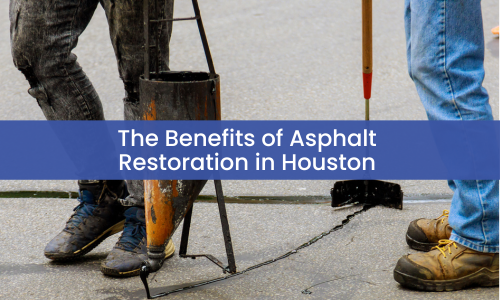Asphalt is a reliable pavement material, providing an excellent mix of durability, flexibility, and cost effectiveness throughout its lifespan. As for lifespan, asphalt pavement will last for at least 15 years if professionally installed.
However, asphalt can last much longer with on-schedule maintenance. By occasionally restoring the asphalt surface, property owners can extract maximum value from their pavement throughout its life.
What is Asphalt Restoration?
Asphalt is a flexible pavement, and many of its benefits are derived from that flexibility. It’s easier and less expensive to install, it withstands thermal expansion and contraction, it provides excellent road performance, and it can be shaped into intricate curves without issue.
Restoring asphalt largely means maintaining that flexibility, so it can continue to withstand traffic and wear. As asphalt tends to lose flexibility with age, occasional interventions are needed as the pavement ages from good to marginal condition. Ideally, the asphalt is kept in good condition for as long as possible, as this will reduce the cost of down-the-road repairs, so to speak.
What does asphalt restoration look like and include? Here are three of the most common asphalt restoration projects that pavement professionals handle:
Sealcoating: Extend the Asphalt’s Life, Appearance and Durability
Sealcoating is performed immediately following installation and every other year thereafter. It’s an inexpensive, but highly effective form of asphalt restoration that can extend your pavement’s life.
Asphalt sealcoat is a mix of bituminous (asphalt) products, an emulsifier, water, sand, and some polymer additives. It’s applied in a liquid form that can be sprayed or broomed directly onto the pavement’s surface. Upon application, the asphalt emulsion will seep through the top layers and fill cavities inside the pavement. Overall, the process is quick and simple, and considered an important part of routine maintenance.
An asphalt sealcoat acts like a layer of wax, or a membrane. It protects against various weather-related hazards, including rain and UV radiation, along with the occasional chemical spill. And because sealcoat helps surface aggregate adhere better, it also provides modest defense against impact.
Sealcoating also restores the asphalt’s appearance, giving it that rich black look that’s associated with new asphalt.
Patch Repairs: Remove Potholes and Strengthen Weak Spots
Asphalt patching is necessary when there are failures related to the pavement’s base. The base supports the asphalt’s surface layers, so it must remain stable for the pavement’s surface to remain stable.
Base failures may be due to unfavorable soil conditions (expansive clays), low quality base materials, poor drainage, or poor compaction methods. Whatever the cause, the effect is usually damaging to the asphalt, with potholes being the most common symptom. Also, base failures have a tendency to spread, so the longer they sit unaddressed, the worse they get.
Patch repairs are a proven way to restore the asphalt’s base and the pavement’s overall integrity. They’re especially common on parking lots and roads, where constant vehicle loading exposes weak spots in the base.
Wherever the setting, cut and patch jobs follow the same general course. The pavement failures are isolated using sawcutters and the damaged pavement is extracted from the cuts, leaving a clean hole that’s surrounded by healthy pavement. With the pavement’s deeper layers exposed, the base can be stabilized, fresh asphalt is rolled into the patch and is then compacted.
Once the asphalt cures, the resulting patch will seal up any pavement weak spots and extend its life, as a result. Further, patching will restore the asphalt’s road performance and provide a smoother ride.
Overlaying: Provide a Like-new Surface for the Pavement
Overlaying is the ultimate form of asphalt maintenance, other than replacing the pavement entirely. Once asphalt reaches about 10 years in age, it’s likely collected an array of surface defects, or it may be in an advanced stage of overall wear.
Even at this point, the asphalt can be restored to its former glory with an overlay or other surface treatment. During asphalt overlay, the top layers of the existing pavement are milled down to a specified depth (usually between 1.5 and 2 inches). Following this step, any base failures are addressed and a new surface course of asphalt is applied to the existing pavement. It’s then compacted and allowed to cure – revealing like-new performance and appearance.
An overlay is a proven way to greatly extend the pavement’s lifespan. In some cases, an overlay can add 10 or more years to asphalt construction, ensuring property owners get maximum value for their money. Without an overlay – or similar surface treatment – the asphalt is far more likely to fail early and fail rapidly. This can leave owners in a vulnerable position should the pavement suddenly become a problem.
Choose a Reputable Houston Contractor for Asphalt Restoration
Asphalt is one of the world’s most reliable paving materials, but occasional maintenance and asphalt restoration will help the pavement last longer.
There are many ways to provide this maintenance and restore the asphalt’s condition, including sealcoating, cutting and patching, and overlaying. These are all effective approaches in this mission, and can be managed by an expert Houston asphalt construction team.
- HOA & Condos – How Asphalt Pavement Can Affect Your Houston Property Values - March 6, 2025
- What Certifications or Licenses Should a Houston Asphalt Contractor Have? - September 17, 2024
- Common Challenges in Concrete Construction - September 11, 2024

